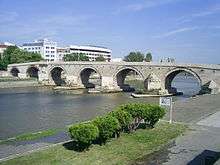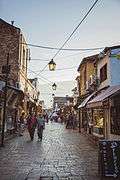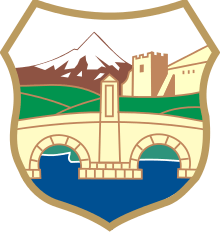Stone Bridge (Skopje)
The Stone Bridge (Macedonian: ![]()
Stone Bridge Камен Мост | |
|---|---|
 | |
| Coordinates | 41°59′49″N 21°25′59″E |
| Crosses | Vardar River |
| Locale | Skopje |
| Characteristics | |
| Design | arch bridge |
| Total length | 214 m |
| Width | 6 m |
%26groups%3D_203ff0127916477d3269d231f7b4c231b35203cd.svg)
| |
The bridge is considered a symbol of Skopje and is the main element of the coat of arms of the city, which in turn is incorporated in the city's flag.[2] It is located in Centar municipality[3] and it connects Macedonia Square to the Old Bazaar.[4]
Architecture
The Stone Bridge is built of solid stone blocks and is supported by firm columns that are connected with 12 semicircular arcs. The bridge is 214 m (702 ft) long and 6 m (20 ft) wide. The guardhouse has recently been reconstructed.[5]
History
The current Stone Bridge was built on Roman foundations under the patronage of Sultan Mehmed II the Conqueror between 1451 and 1469.[6][7][8] Most of the Stone Bridge originates from the Ottoman period[9] and throughout the centuries, the Stone Bridge was often damaged and then repaired. There is historical evidence that it once suffered during the great earthquake of 1555 which heavily damaged or destroyed four pillars. Renovations were carried out the same year. Some executions have also taken place on this bridge, such as the execution of Karposh in 1689.
In 1944, explosives were placed on the bridge by Nazis. Upon a request from city notables, the Germans give up at the last minute and the bridge was saved from destruction. The last reconstruction of the bridge began in 1994. Over seven years during the Stone Bridge refurbishment of the 1990s, people were not allowed to cross the structure and for many craftsmen from the nearby Old Bazaar it resulted in negative economic effects.[10] The watchtower shaped like a mihrab was reconstructed in 2008.
Two parts of Skopje that have symbolised its urban contrasts of "Ottoman" or "modern", the "historic" or "socialist", "Albanian" or "Macedonian" are split by the river Vardar and linked by the Stone Bridge.[9] In the twenty first century, members of the majority and minority groups of the capital city view the stone bridge as representing the split between two parts of Skopje.[9]
Gallery
 Stone Bridge and Macedonia Square in the early 1920s
Stone Bridge and Macedonia Square in the early 1920s Stone Bridge in 1909
Stone Bridge in 1909 Inscription on the bridge
Inscription on the bridge- Stone Bridge at night
- Memorial plaque on the site of Karposh's execution
- View from the top
- Lateral view
 Stone Bridge, photo from the 1950s
Stone Bridge, photo from the 1950s A view of Stone Bridge and the Square
A view of Stone Bridge and the Square
See also
References
- Knowledge Bank at OSU
- Official portal of the city of Skopje: City symbols. – Retrieved on 13 May 2009.
- Ragaru 2008, p. 553.
- Stone bridge, Skopje, Macedonia Archived 2011-05-26 at the Wayback Machine
- Kameniot Most na Vardar, Skopje
- Macedonia, Bradt Travel Guid, Thammy Evans, Bradt Travel Guides, 2010, ISBN 1841622974, p. 139.
- Skopje In Your Pocket 2006-2007, Sco, Jeroen van Marle, In Your Pocket, p. 27.
- Macedonia, Jovan Popovski, Turistička štampa, 1969, p. 66.
- Ragaru 2008, p. 536.
- Ragaru, Nadege (2008). "The Political Uses and Social Lives of "National Heroes": Controversies over Skanderbeg's Statue in Skopje". Südosteuropa. 56 (4): 554.CS1 maint: ref=harv (link)

